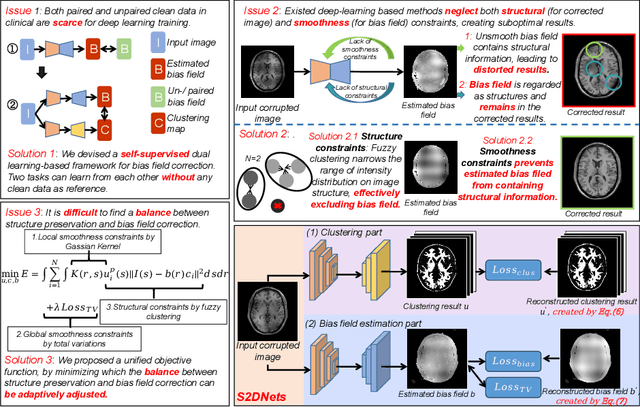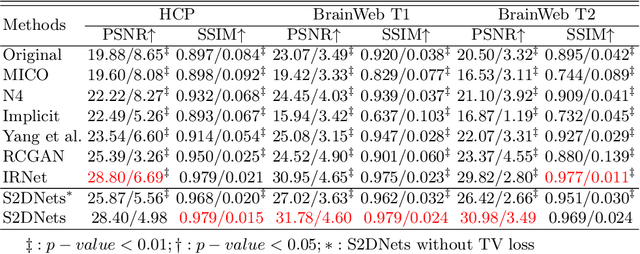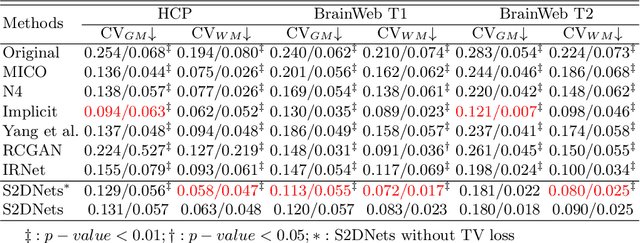Dong Liang
NeuroSwift: A Lightweight Cross-Subject Framework for fMRI Visual Reconstruction of Complex Scenes
Oct 02, 2025Abstract:Reconstructing visual information from brain activity via computer vision technology provides an intuitive understanding of visual neural mechanisms. Despite progress in decoding fMRI data with generative models, achieving accurate cross-subject reconstruction of visual stimuli remains challenging and computationally demanding. This difficulty arises from inter-subject variability in neural representations and the brain's abstract encoding of core semantic features in complex visual inputs. To address these challenges, we propose NeuroSwift, which integrates complementary adapters via diffusion: AutoKL for low-level features and CLIP for semantics. NeuroSwift's CLIP Adapter is trained on Stable Diffusion generated images paired with COCO captions to emulate higher visual cortex encoding. For cross-subject generalization, we pretrain on one subject and then fine-tune only 17 percent of parameters (fully connected layers) for new subjects, while freezing other components. This enables state-of-the-art performance with only one hour of training per subject on lightweight GPUs (three RTX 4090), and it outperforms existing methods.
MultiMedEdit: A Scenario-Aware Benchmark for Evaluating Knowledge Editing in Medical VQA
Aug 09, 2025Abstract:Knowledge editing (KE) provides a scalable approach for updating factual knowledge in large language models without full retraining. While previous studies have demonstrated effectiveness in general domains and medical QA tasks, little attention has been paid to KE in multimodal medical scenarios. Unlike text-only settings, medical KE demands integrating updated knowledge with visual reasoning to support safe and interpretable clinical decisions. To address this gap, we propose MultiMedEdit, the first benchmark tailored to evaluating KE in clinical multimodal tasks. Our framework spans both understanding and reasoning task types, defines a three-dimensional metric suite (reliability, generality, and locality), and supports cross-paradigm comparisons across general and domain-specific models. We conduct extensive experiments under single-editing and lifelong-editing settings. Results suggest that current methods struggle with generalization and long-tail reasoning, particularly in complex clinical workflows. We further present an efficiency analysis (e.g., edit latency, memory footprint), revealing practical trade-offs in real-world deployment across KE paradigms. Overall, MultiMedEdit not only reveals the limitations of current approaches but also provides a solid foundation for developing clinically robust knowledge editing techniques in the future.
Towards Globally Predictable k-Space Interpolation: A White-box Transformer Approach
Aug 06, 2025Abstract:Interpolating missing data in k-space is essential for accelerating imaging. However, existing methods, including convolutional neural network-based deep learning, primarily exploit local predictability while overlooking the inherent global dependencies in k-space. Recently, Transformers have demonstrated remarkable success in natural language processing and image analysis due to their ability to capture long-range dependencies. This inspires the use of Transformers for k-space interpolation to better exploit its global structure. However, their lack of interpretability raises concerns regarding the reliability of interpolated data. To address this limitation, we propose GPI-WT, a white-box Transformer framework based on Globally Predictable Interpolation (GPI) for k-space. Specifically, we formulate GPI from the perspective of annihilation as a novel k-space structured low-rank (SLR) model. The global annihilation filters in the SLR model are treated as learnable parameters, and the subgradients of the SLR model naturally induce a learnable attention mechanism. By unfolding the subgradient-based optimization algorithm of SLR into a cascaded network, we construct the first white-box Transformer specifically designed for accelerated MRI. Experimental results demonstrate that the proposed method significantly outperforms state-of-the-art approaches in k-space interpolation accuracy while providing superior interpretability.
HOComp: Interaction-Aware Human-Object Composition
Jul 22, 2025Abstract:While existing image-guided composition methods may help insert a foreground object onto a user-specified region of a background image, achieving natural blending inside the region with the rest of the image unchanged, we observe that these existing methods often struggle in synthesizing seamless interaction-aware compositions when the task involves human-object interactions. In this paper, we first propose HOComp, a novel approach for compositing a foreground object onto a human-centric background image, while ensuring harmonious interactions between the foreground object and the background person and their consistent appearances. Our approach includes two key designs: (1) MLLMs-driven Region-based Pose Guidance (MRPG), which utilizes MLLMs to identify the interaction region as well as the interaction type (e.g., holding and lefting) to provide coarse-to-fine constraints to the generated pose for the interaction while incorporating human pose landmarks to track action variations and enforcing fine-grained pose constraints; and (2) Detail-Consistent Appearance Preservation (DCAP), which unifies a shape-aware attention modulation mechanism, a multi-view appearance loss, and a background consistency loss to ensure consistent shapes/textures of the foreground and faithful reproduction of the background human. We then propose the first dataset, named Interaction-aware Human-Object Composition (IHOC), for the task. Experimental results on our dataset show that HOComp effectively generates harmonious human-object interactions with consistent appearances, and outperforms relevant methods qualitatively and quantitatively.
Structure and Smoothness Constrained Dual Networks for MR Bias Field Correction
Jul 02, 2025



Abstract:MR imaging techniques are of great benefit to disease diagnosis. However, due to the limitation of MR devices, significant intensity inhomogeneity often exists in imaging results, which impedes both qualitative and quantitative medical analysis. Recently, several unsupervised deep learning-based models have been proposed for MR image improvement. However, these models merely concentrate on global appearance learning, and neglect constraints from image structures and smoothness of bias field, leading to distorted corrected results. In this paper, novel structure and smoothness constrained dual networks, named S2DNets, are proposed aiming to self-supervised bias field correction. S2DNets introduce piece-wise structural constraints and smoothness of bias field for network training to effectively remove non-uniform intensity and retain much more structural details. Extensive experiments executed on both clinical and simulated MR datasets show that the proposed model outperforms other conventional and deep learning-based models. In addition to comparison on visual metrics, downstream MR image segmentation tasks are also used to evaluate the impact of the proposed model. The source code is available at: https://github.com/LeongDong/S2DNets}{https://github.com/LeongDong/S2DNets.
* 11 pages, 3 figures, accepted by MICCAI
DUN-SRE: Deep Unrolling Network with Spatiotemporal Rotation Equivariance for Dynamic MRI Reconstruction
Jun 12, 2025Abstract:Dynamic Magnetic Resonance Imaging (MRI) exhibits transformation symmetries, including spatial rotation symmetry within individual frames and temporal symmetry along the time dimension. Explicit incorporation of these symmetry priors in the reconstruction model can significantly improve image quality, especially under aggressive undersampling scenarios. Recently, Equivariant convolutional neural network (ECNN) has shown great promise in exploiting spatial symmetry priors. However, existing ECNNs critically fail to model temporal symmetry, arguably the most universal and informative structural prior in dynamic MRI reconstruction. To tackle this issue, we propose a novel Deep Unrolling Network with Spatiotemporal Rotation Equivariance (DUN-SRE) for Dynamic MRI Reconstruction. The DUN-SRE establishes spatiotemporal equivariance through a (2+1)D equivariant convolutional architecture. In particular, it integrates both the data consistency and proximal mapping module into a unified deep unrolling framework. This architecture ensures rigorous propagation of spatiotemporal rotation symmetry constraints throughout the reconstruction process, enabling more physically accurate modeling of cardiac motion dynamics in cine MRI. In addition, a high-fidelity group filter parameterization mechanism is developed to maintain representation precision while enforcing symmetry constraints. Comprehensive experiments on Cardiac CINE MRI datasets demonstrate that DUN-SRE achieves state-of-the-art performance, particularly in preserving rotation-symmetric structures, offering strong generalization capability to a broad range of dynamic MRI reconstruction tasks.
HAVIR: HierArchical Vision to Image Reconstruction using CLIP-Guided Versatile Diffusion
Jun 06, 2025Abstract:Reconstructing visual information from brain activity bridges the gap between neuroscience and computer vision. Even though progress has been made in decoding images from fMRI using generative models, a challenge remains in accurately recovering highly complex visual stimuli. This difficulty stems from their elemental density and diversity, sophisticated spatial structures, and multifaceted semantic information. To address these challenges, we propose HAVIR that contains two adapters: (1) The AutoKL Adapter transforms fMRI voxels into a latent diffusion prior, capturing topological structures; (2) The CLIP Adapter converts the voxels to CLIP text and image embeddings, containing semantic information. These complementary representations are fused by Versatile Diffusion to generate the final reconstructed image. To extract the most essential semantic information from complex scenarios, the CLIP Adapter is trained with text captions describing the visual stimuli and their corresponding semantic images synthesized from these captions. The experimental results demonstrate that HAVIR effectively reconstructs both structural features and semantic information of visual stimuli even in complex scenarios, outperforming existing models.
Integer Binary-Range Alignment Neuron for Spiking Neural Networks
Jun 06, 2025Abstract:Spiking Neural Networks (SNNs) are noted for their brain-like computation and energy efficiency, but their performance lags behind Artificial Neural Networks (ANNs) in tasks like image classification and object detection due to the limited representational capacity. To address this, we propose a novel spiking neuron, Integer Binary-Range Alignment Leaky Integrate-and-Fire to exponentially expand the information expression capacity of spiking neurons with only a slight energy increase. This is achieved through Integer Binary Leaky Integrate-and-Fire and range alignment strategy. The Integer Binary Leaky Integrate-and-Fire allows integer value activation during training and maintains spike-driven dynamics with binary conversion expands virtual timesteps during inference. The range alignment strategy is designed to solve the spike activation limitation problem where neurons fail to activate high integer values. Experiments show our method outperforms previous SNNs, achieving 74.19% accuracy on ImageNet and 66.2% mAP@50 and 49.1% mAP@50:95 on COCO, surpassing previous bests with the same architecture by +3.45% and +1.6% and +1.8%, respectively. Notably, our SNNs match or exceed ANNs' performance with the same architecture, and the energy efficiency is improved by 6.3${\times}$.
Patch-based Reconstruction for Unsupervised Dynamic MRI using Learnable Tensor Function with Implicit Neural Representation
May 28, 2025Abstract:Dynamic MRI plays a vital role in clinical practice by capturing both spatial details and dynamic motion, but its high spatiotemporal resolution is often limited by long scan times. Deep learning (DL)-based methods have shown promising performance in accelerating dynamic MRI. However, most existing algorithms rely on large fully-sampled datasets for training, which are difficult to acquire. Recently, implicit neural representation (INR) has emerged as a powerful scan-specific paradigm for accelerated MRI, which models signals as a continuous function over spatiotemporal coordinates. Although this approach achieves efficient continuous modeling of dynamic images and robust reconstruction, it faces challenges in recovering fine details and increasing computational demands for high dimensional data representation. To enhance both efficiency and reconstruction quality, we propose TenF-INR, a novel patch-based unsupervised framework that employs INR to model bases of tensor decomposition, enabling efficient and accurate modeling of dynamic MR images with learnable tensor functions. By exploiting strong correlations in similar spatial image patches and in the temporal direction, TenF-INR enforces multidimensional low-rankness and implements patch-based reconstruction with the benefits of continuous modeling. We compare TenF-INR with state-of-the-art methods, including supervised DL methods and unsupervised approaches. Experimental results demonstrate that TenF-INR achieves high acceleration factors up to 21, outperforming all comparison methods in image quality, temporal fidelity, and quantitative metrics, even surpassing the supervised methods.
LoD: Loss-difference OOD Detection by Intentionally Label-Noisifying Unlabeled Wild Data
May 19, 2025Abstract:Using unlabeled wild data containing both in-distribution (ID) and out-of-distribution (OOD) data to improve the safety and reliability of models has recently received increasing attention. Existing methods either design customized losses for labeled ID and unlabeled wild data then perform joint optimization, or first filter out OOD data from the latter then learn an OOD detector. While achieving varying degrees of success, two potential issues remain: (i) Labeled ID data typically dominates the learning of models, inevitably making models tend to fit OOD data as IDs; (ii) The selection of thresholds for identifying OOD data in unlabeled wild data usually faces dilemma due to the unavailability of pure OOD samples. To address these issues, we propose a novel loss-difference OOD detection framework (LoD) by \textit{intentionally label-noisifying} unlabeled wild data. Such operations not only enable labeled ID data and OOD data in unlabeled wild data to jointly dominate the models' learning but also ensure the distinguishability of the losses between ID and OOD samples in unlabeled wild data, allowing the classic clustering technique (e.g., K-means) to filter these OOD samples without requiring thresholds any longer. We also provide theoretical foundation for LoD's viability, and extensive experiments verify its superiority.
 Add to Chrome
Add to Chrome Add to Firefox
Add to Firefox Add to Edge
Add to Edge